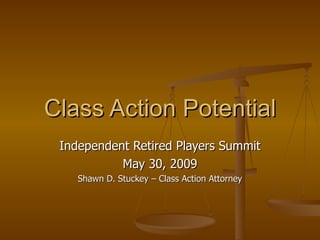Shawn Stuckey Class Action Potential
- 1. Class Action Potential Independent Retired Players Summit May 30, 2009 Shawn D. Stuckey – Class Action Attorney
- 2. Reason for Player Advocacy “The NFL Players Association’s legal department will help me! I called and called and called – no answer. I left messages with every single attorney and spoke with whomever would speak with me in the office - no one stepped forward….”
- 3. Introduction to Framework Goals: Provide the legal and procedural framework for establishing a class action so that members can understand if they have a potential viable action Brief discussion of the recent licensing class action
- 4. What is a class Action? A class action is a representative suit on behalf of a group of persons (or entities) similarly situated. One or more representatives of the harmed group go to court on behalf of everyone else who was similarly affected.
- 5. Purpose of a Class Action J udicial economy and efficiency Class actions have allowed individuals to stand up against the most powerful industries in the world and to hold them accountable for their actions.
- 6. Four Major Types of Class Actions Consumer Class Actions –E.g., price-fixing a product or illegal charges on bills; Product liability/Personal Injury Class Actions – E.g., defective products, Drugs with harmful side effects that may have been prescribed by an football team’s doctor; Securities Class Actions Employment Class Actions – violations of the Labor Code.
- 7. Class Action Requirements Numerosity – “Numbers” : large number of people affected; Commonality or “Common claims” : plaintiffs in the case must have similar claims against the defendants. Typicality or “Typical class” : the representatives must have the same claims and defenses as those they are representing. Fair and adequate representation : The representative plaintiffs and the class lawyers must be good caretaker for the group’s claims.
- 8. Class Certification Class certification is a procedural device by which the court allows a few designated appointees to represent the other members of the class. E.g.: If the above-mentioned criteria are met and all the class wants is an order telling the defendant(s) to stop doing something (e.g. to discontinue the “head slap” in football or discontinue “the wedge” in special teams), a judge will usually agree to “certify” the class. Mass tort cases, in which a lot of people have been physically injured in a disaster or by a dangerous product, are often denied class action status because the causes and extent of individual injuries vary so much from person to person.
- 9. Recent Class Action Against NFLPA Based on allegations that the union breached a fiduciary duty to market the likenesses and names of retired players. The theory of liability: the union persuaded the retired players to assign the right to market their likenesses and names to the NFLPA — and that the NFLPA then did nothing at all to market the players’ likenesses and names. The court found that the NFLPA did this merely to prevent some other organization (or the players themselves) from gathering the marketing rights to the likenesses and names on a mass basis, and actually marketing the likenesses and names.Â
- 10. Recent Class Action Against NFLPA – (Cont.) – the NFLPA owes a fiduciary duty to the players. As Mike Florio of Profootball.com wrote: “ If true (and the jury found that it is), it’s shameful, and despicable. The jury essentially found that, under the guise of helping retired players, the NFLPA screwed them, making no effort to market the rights to their likenesses and names in order to preserve the millions and millions that were being generated by the marketing of the rights to the likenesses and names of active players.”










